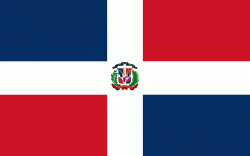San José de Ocoa (Provincia de San José de Ocoa)
San José de Ocoa, or simply Ocoa, is the capital of San José de Ocoa province in the Dominican Republic. It is located in a valley in the southern region of the Central Cordillera mountain range.
The town was founded in 1805 by people from the southern town of Baní. The Spanish Canarian descendants were the first ethnic group to settle in San José de Ocoa, remaining a significant minority in the town. Other families from Spain, Italy and France would soon follow. Blacks also would later settle in San José de Ocoa, most of them being Afro-Caribbean Cocolo descendants arriving from San Pedro de Macoris.
In December 1858, San José de Ocoa was elevated to the category of municipality in the former province of Santo Domingo; in 1895, it was transferred to the province of Azua. In 1944 when the province of Peravia was created, San José de Ocoa became a municipality of this province. Finally, the town became the capital municipality of the new province of San José de Ocoa on 6 September 2000.
The town was founded in 1805 by people from the southern town of Baní. The Spanish Canarian descendants were the first ethnic group to settle in San José de Ocoa, remaining a significant minority in the town. Other families from Spain, Italy and France would soon follow. Blacks also would later settle in San José de Ocoa, most of them being Afro-Caribbean Cocolo descendants arriving from San Pedro de Macoris.
In December 1858, San José de Ocoa was elevated to the category of municipality in the former province of Santo Domingo; in 1895, it was transferred to the province of Azua. In 1944 when the province of Peravia was created, San José de Ocoa became a municipality of this province. Finally, the town became the capital municipality of the new province of San José de Ocoa on 6 September 2000.
Map - San José de Ocoa (Provincia de San José de Ocoa)
Map
Country - Dominican_Republic
 |
 |
| Flag of the Dominican Republic | |
The native Taíno people had inhabited Hispaniola before the arrival of Europeans, dividing it into five chiefdoms. They had constructed an advanced farming and hunting society, and were in the process of becoming an organized civilization. The Taínos also inhabited Cuba, Jamaica, Puerto Rico, and the Bahamas. The Genoese mariner Christopher Columbus explored and claimed the island for Castile, landing there on his first voyage in 1492. The colony of Santo Domingo became the site of the first permanent European settlement in the Americas and the first seat of Spanish colonial rule in the New World. It would also become the site to introduce importations of enslaved Africans to the Americas. In 1697, Spain recognized French dominion over the western third of the island, which became the independent state of Haiti in 1804.
Currency / Language
| ISO | Currency | Symbol | Significant figures |
|---|---|---|---|
| DOP | Dominican peso | $ | 2 |
| ISO | Language |
|---|---|
| ES | Spanish language |
















